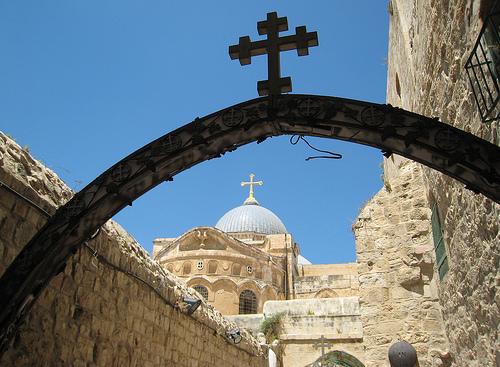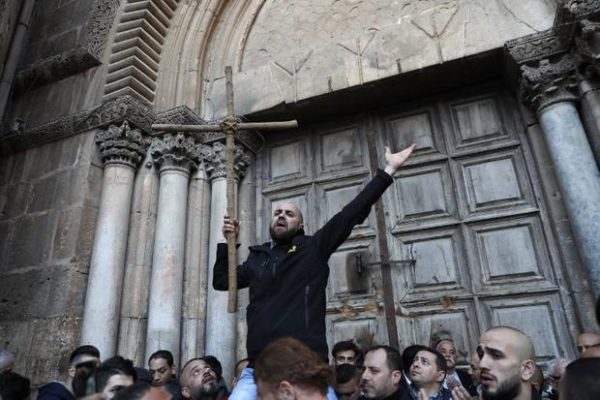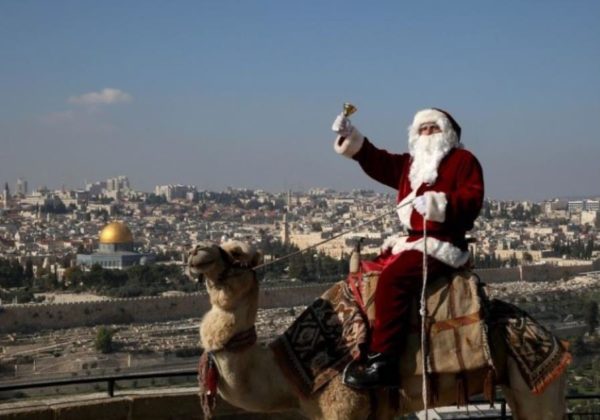
Jesus in Jerusalem
Jesus first visited Jerusalem as a child with his mother: they walked through the markets and attended festivals in the city.. As an adult, Jesus went to Jerusalem to preach his message[1]and it was in Jerusalem where Muslims and Christians believe he cured the blind and brought the dead back to life.[2] Jerusalem is also the site where, according to the christian tradition, Jesus was tried and crucified.J.[3]
Since the time Jesus visited and preached in Jerusalem, Christians have’ lived there leaving only once for 60 years around 70 AD following the Jewish rebellion against the Roman state in Jerusalem, when they had to leave the city with Bishop Simon. Shortly after this, Titus, the Roman general, attacked Jerusalem and destroyed it completely. For about 60 years, the city remained uninhabited until Emperor Hadrian built a new city and called it Aelia. Only then did the Christians return and begin choosing local bishops to lead their churches and congregations. .[4]
Jerusalem as a Christian City
Christianity in Jerusalem remained a minority religion until the fourth century when Constantine, the Emperor of Byzantium, adopted Christianity as the formal religion of the empire. Shortly after, Constantine’s mother, Empress Helena, ordered the construction of the most sacred church in the history of Christianity: the Church of the Holy Sepulcher, on the Golgotha where Jesus is believed to have been tried, sentenced to death, and buried.[5]
Christian and Muslim Relations in the City 
The Christians of Jerusalem lived peacefully under the early rule of Muslims. The first interaction between Christians and Muslims in the city happened in 638 AD, after the Muslims captured Jerusalem, when the second caliph Omar bin Al-Khattab was received by Jerusalem’s patriarch Sophornius, who refused to surrender the city’s keys until Omar came to retrieve them and signed a written pledge that guarantee the safety and religious freedom of the Christians in the city. t.[6] During his stay in Jerusalem, Omar visited the Church of the Holy Sepulcher but refused to pray inside, despite an invitation from the patriarch, because he feared this would provide a precedent for later zealous Muslims to change the church into a mosque and endanger the Christian character of the place.[7]
here were periods of tension and tremendous violence in the later history of both religions. During the reign of the Fatimid Caliph Al-Hakim Bi Amr-Allah the Church of the Holy Sepulcher was totally destroyed and many Christians were killed-[8] Fatal clashes and riots broke out after this. The Church was rebuilt shortly after, during the era of Al-Zaher, the son of Al-Hakim-and this was symptomatic of a golden era in which the relations between the followers of the two religions in the city was marked by mutual tolerance and respect.. Such relations were ruined again during the rule of the Seljuk Turks in Jerusalem, and were completely destroyed when the Crusaders took over Jerusalem, brutally killed hundreds of thousands of its Muslim inhabitants, and turned their mosques into churches or stables.[9] However, Christians of different sects suffered too–when Jerusalem was turned into a Latin Kingdom ruled by Catholics, Orthodox Christians were obliged to turn into Catholic Christians.[10]
Christian landmarks in Jerusalem
Jerusalem is the only city in the world that has 158 churches, and is a city to which Christians of every denomination from around the world come to perform pilgrimage at. , Pilgrims come to visit the Church of the Holy Sepulcher from where Christians believe that Jesus walked to his crucifixion on Resurrection Sunday. Christians celebrate Palm Sunday where Jesus is believed to have ridden on his donkey from Ezzaria to Jerusalem while people brushed his way with carpets and cloths.[11]

Jerusalem is considered one of the Great Five patriarchate centers which include Rome, Alexandria, Constantinople and Antioch, and holds a central importance in the Christian Church on a global scale.[13] alf of the old city of Jerusalem is inhabited by Christians distributed between the Christian Quarter and the Armenian Quarter.[14]
In contemporary Jerusalem, what unites many Christians and Muslims is in fact the Israeli threat. Christians and Muslims are often at the forefront of defending each other’s holy places and struggle against the Israeli policies and violence together.
[1] Raouf Abujaber, Arab Christianity and Jerusalem (UK: Gilgamesh Publishing, 2012), 10
[2] “Miracles of Jesus,” http://www.about-jesus.org/miracles.htm
[3] “Christian Holy Places in Jerusalem,” http://info.wafa.ps/atemplate.aspx?id=4240
[4] Abujaber, Arab Christianity, 10
[5] “Jerusalem in Christianity,” https://qudsinfo.com/info-details/القدس-في-العقيدة-المسيحية/
[6] Abujaber, Arab Christianity, 10
[7] “The Persian Invasion: Church of the Holy Sepulcher,” https://www.google.com/url?sa=t&rct=j&q=&esrc=s&source=web&cd=18&cad=rja&uact=8&ved=2ahUKEwiK6sfOv-3cAhXuuFkKHbRgCVEQFjARegQICRAB&url=http%3A%2F%2Fwww.sepulchre.custodia.org%2Fdefault.asp%3Fid%3D4081&usg=AOvVaw1A2e2ME7NQ8LNM1SGaGsny
[8] Joseph Millis, Jerusalem: the Illustrated History of the Holy City (London: Andre Deutsch, 2012), 51
[9] “Jerusalem in Christianity,” https://qudsinfo.com/info-details/القدس-في-العقيدة-المسيحية/
[10]“Christian Landmarks in Jerusalem,” last modified March 25, 2013, http://www.dci.plo.ps/article/445/المعالم-المسيحية-في-القدس
[11] “Christian Holy Places in Jerusalem,” http://info.wafa.ps/atemplate.aspx?id=4240
[12] “Christian Landmarks in Jerusalem,” last modified March 25, 2013, http://www.dci.plo.ps/article/445/المعالم-المسيحية-في-القدس
[13] “Pentarchy,” https://www.britannica.com/topic/pentarchy
[14] “Jerusalem in Christianity,” https://qudsinfo.com/info-details/القدس-في-العقيدة-المسيحية/



